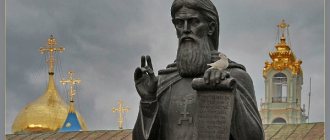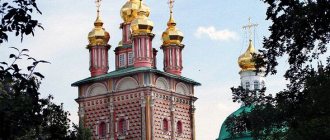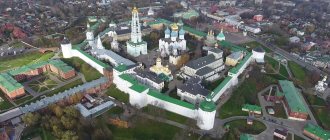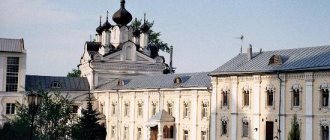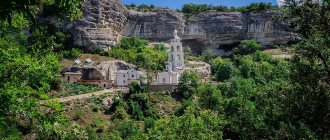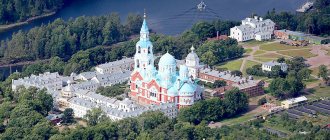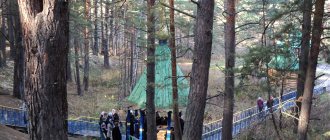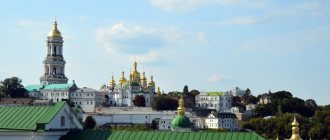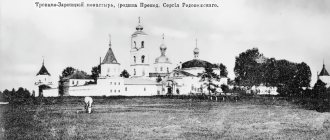Trinity-Sergius Lavra - the spiritual monastery of the Russian Church
Not far from Moscow, in the city of Sergiev Posad, there is the largest Orthodox monastery in Russia. Its church name is Holy Trinity Sergius Lavra. Created almost seven centuries ago, today it is the educational center of the Russian Orthodox Church. One of its cathedrals houses the relics of the founder of the Lavra, the spiritual ascetic of all Rus' - Sergius of Radonezh.
How to get to the Trinity-Sergius Lavra
Panorama of the architectural ensemble of the Trinity-Sergius Lavra photo
The Trinity Lavra of Sergius is located in the city of Sergiev Posad, Moscow region. The distance to Moscow is 70 kilometers (if you count from the Yaroslavsky station, from where commuter trains depart in this direction).
There are several ways to get to the Trinity-Sergius Lavra by public transport.
Electric train
Travel time from Yaroslavsky station to Sergiev Posad, depending on the type of train, is from 1 hour to 1.5 hours. Electric trains depart every 10-30 minutes. The cost of a ticket for 2021 is from 335 rubles one way (this is the most ordinary slow train, not fast or express).
Bus
From the VDNKh metro station by bus No. 388, running on the Moscow-Sergiev Posad route. Travel time, as on a “standard” train, is from 1 hour.
From the Sergiev Posad railway station to the monastery, walk 5-10 minutes along Sergievskaya Street (from the station immediately to the right and down the street).
By car
Along the Yaroslavskoye Highway from Moscow, highway M 8, then exit the highway towards Sergiev Posad following the sign.
Where to stay in Sergiev Posad:
The popularity of the Trinity-Sergius Lavra is such that a decent infrastructure has long been formed around it in the city, which is also located on the famous Russian tourist route “Golden Ring”. If you want to stay in the city for a night or more, you can easily find an option here to suit your taste and budget: from inexpensive hostels for pilgrims to quite comfortable 4-star hotels. Moreover, almost all of them have high guest ratings in different booking systems.
Prices per night: on average from 2000 to 3000 rubles with breakfast for a double room, hotels often make discounts and issue special offers, you can especially get lucky if you book literally the day before check-in - prices often fall by 25-40% from usual.
See also: How to get to the Philharmonic 2
How to get to the Trinity-Sergius Lavra
You can arrive to Lavra by electric train from the Yaroslavsky station, which runs from the Komsomolskaya metro station to the suburban station Balakirevo, or to the Alexandrov station. It is also convenient to get there by bus from VDNH. Route No. 388 goes to Sergiev Posad, the interval between buses is only 10-15 minutes. All information can be found on the official website of the Trinity-Sergius Lavra.
How to get to Sergiev Posad by bus
It’s very convenient to get there on your own, take intercity bus No. 388. Take the metro to the VDNKh station, follow the sign to the Cosmos Hotel. There are a lot of arrow signs, follow them strictly.
Coming out of the crossing, look in the direction of the traffic, you see the Cosmos Hotel, go to it, after a hundred meters there is an intersection with a traffic light in front of you, turn your head to the right and see the VDNH Bus Station, take bus 388 to Sergiev Posad, they leave every twenty minutes, so don't worry about the schedule.
Bus 388 schedule
The fare is 240 rubles, travel time depends on traffic jams, the earlier you leave, the fewer there are. Leaving on the first bus at 06-40 you will be there in exactly one hour and fifteen minutes.
When approaching the city of Sergiev Posad, warn the driver to stop opposite the Trinity-Sergius Lavra. The bus will stop opposite the Pyatnitskaya tower of the monastery.
Lavra
- a huge male Orthodox monastery with the most important spiritual and historical significance
At the crossing, go to the opposite side, you are there. By the way, next to the crossing there is a public toilet, very clean, then you follow to the central entrance to the Lavra, the Red Gate Tower.
Excursion into the history of the monastery
Founded by Sergius of Radonezh in 1337, today the Lavra reports directly to His Holiness the Patriarch. During the history of its existence, the oldest Orthodox monastery has worthily endured the consequences of the heyday and periods of oppression by state authorities. In 1920, the Lavra closed. Part of its complex was used to store museum exhibits, and part was converted into residential premises. The revival took place in 1946 and subsequent years.
The Lavra preserves the relics of not only the clergy, but also the royal Godunov dynasty. Buried on its territory are: publicist and Slavophile Ivan Sergeevich Aksakov, doctor, diplomat and thinker Konstantin Nikolaevich Leontyev, Russian philosopher and critic Vasily Vasilyevich Rozanov, and other cultural figures who served for the benefit of the development of Russian and world spirituality. The active role of the spiritual capital was inherent in the Lavra throughout the entire historical stage of its existence.
This place is associated with the names of the ascetics of Russian Orthodoxy - St. Maxim the Greek, Nikon of Radonezh, Epiphanius the Wise and other representatives of the Church. The monastery received its venerable Lavra status in 1744. From the beginning of the 16th century to the present day, a unique library of spiritual culture from handwritten and printed spiritual works is gradually being formed here.
The Lavra received its beginning as a spiritual and educational center in 1814. At this time, the Theological Academy, founded back in 1685, was located here. Today, the operating monastery continues to play a leading role in the educational, educational and spiritual spheres of the Orthodox Church.
Holy Trinity Sergius Monastery becomes Lavra
Lavra in Sergiev Posad
The new flourishing of the Holy Trinity Monastery was marked by the accession to the throne of the daughter of Peter I, Elizaveta Petrovna; by decree of the empress, the monastery was awarded the honorary title “Lavra”, and the Metropolitan of Moscow became its head.
By the end of the 18th century, up to thirty new settlements had grown around the monastery. As a rule, they were named according to their location; later all the settlements were united into six parishes, according to the number of parish churches.
In 1782, Catherine II ordered the establishment of Sergievsky Posad from Sergievsky settlements and villages. Posads differed from cities in their lower status, which was expressed in a smaller number of local governments, in the absence of a coat of arms, the right to which only cities had the right.
Sergievsky Posad
But as now, so then, the Trinity Lavra of Sergius remained the center of the city; it was built by the best architects of Russia; its ensemble included more than fifty buildings, including the Moscow Theological Academy and Seminary.
Architecture of the Trinity-Sergius Lavra
The largest temple of the Lavra, the Assumption Cathedral, was built by order of Ivan the Terrible for twenty-six years. The project is reminiscent of the Assumption Cathedral of the Moscow Kremlin.
The famous healing spring flowing on the central square of the monastery was discovered in 1644, during the renovation of the porch of the Assumption Cathedral. The first to see from its water was the blind monk Paphnutius.
Sergievo Trinity Lavra
The thousands of healings of the sick and crippled that followed him made us believe in the holiness of the source. Today, like hundreds of years ago, hundreds of pilgrims flock to him for healing every day.
The refectory was built in the 17th century, by order of the princes Peter and John Alekseevich.
The central place in the architecture of the Lavra is occupied by a five-tiered bell tower; it is visible from all sides, several kilometers before the entrance to the monastery.
Sergiev Posad Monastery
Not far from the bell tower, a memorable tetrahedral obelisk made of stone was installed in 1792 by Metropolitan Platon Levshin. During the War of 1812, sitting in the fall in burned Moscow, successive bands of European educators twice attempted to capture and plunder the Lavra.
The first time a thick fog fell on them, they got lost and had difficulty returning to Moscow. Another time they saw elders galloping towards them and turned back in horror.
Organization of the Theological Academy within the walls of the Trinity Lavra of Sergius
In 1814, the Moscow Theological Academy was moved to Trinity Lavra of Sergius, at which time the Lavra became not only a spiritual, but also an educational center; it had a printing house and published books and brochures of religious content.
Lavra in Sergiev Posad
It is symbolic that within the walls of the monastery there are theological schools; now more than six hundred people, future ministers of the church, are studying there. After four years of study at the Seminary, those who wish can continue their studies at the Theological Academy.
Now the theological schools also include the Regina and Icon Painting Schools, in which the traditions of church art are being revived and continued.
In the 19th century, a road and highway were built from Moscow to Pasad, which immediately increased the number of pilgrims coming from all over Russia. The population of Sergiev Posad also increased, but the most terrible test was approaching. The Bolsheviks - atheists - came to power
Bell tower of the Lavra
Bell tower of the Lavra, years of construction - from 1741 to 1768. The height of the Trinity-Sergius belfry is 88 meters, it was built according to the design of the architect D. V. Ukhtomsky. The five-tiered bell tower is considered the most beautiful in Russia. Here is the largest, weighing more than 70 tons, the Tsar Bell. The restoration of the belfry was carried out only in 2014, on the eve of the celebration of the 700th anniversary of St. Sergius.
Assumption Cathedral
Assumption Cathedral. Construction was carried out in 1585 by decree of Ivan the Terrible. The five-domed cathedral was built in the center of the Lavra. The central golden dome was erected in honor of the Savior, the remaining domes, designed like a starry sky, are in honor of the Holy Mother of God. Externally, this is the most fundamental of the Lavra’s cathedrals. Inside, if you enter it, you create an amazing feeling of space, height and abundance of light. The temple remained unpainted for almost a century, and only in 1684, at the expense of Archbishop Moses of Ryazan, master icon painters were invited and under the leadership of Dm. Plekhanov Cathedral was decorated with frescoes depicting saints and noble persons of the princely family. The main shrine of the Cathedral remains the funeral of Sergius of Radonezh.
Church of the Solovetsky Wonderworkers
Church of the Solovetsky Wonderworkers. Construction time: 1635-1637. This is the only tented temple in the Lavra, which houses a shrine - the ancient icon “The Sign”, with the image of Zosima and Savvaty of Solovetsky, appearing before the appearance of the Mother of God. The temple is part of a complex of buildings created in different historical periods, the buildings of which house the monastery library, the chambers of the governor of the Lavra and the Cathedral Chamber.
Church of St. John the Baptist
The Church of St. John the Baptist (1693-1699) was created on the site of the main gate to the Monastery and was erected at the end of the 17th century at the expense of the philanthropist G. Stroganov. At the time of its construction, the haram looked somewhat different; the five-domed structure was restored at the end of the last century, already under the leadership of V.I. Baldin, this architectural solution emphasized the stylistic commonality of the entire ensemble of the Trinity-Sergius Lavra. The magnificent iconostasis in the Church of St. John the Baptist is well lit and surprises with its splendor.
Refectory Church
Church of St. Sergius with the Refectory Chamber (1686–1692).
These are not all the temples and cathedrals of the Trinity-Sergius Lavra. Each of the buildings has its own history, characteristics and spiritual and cultural value. And all together they form an amazing place, the center of history, spirituality, artistic rarities and the center of spiritual Orthodox culture in Rus'.
In addition to churches and temples, on the territory of the Lavra there is a source of spring water, where anyone can quench their thirst.
It seems important to say a few words about the founder of this center, hieromonk of the Russian Church Sergius of Radonezh (1314-1392). His name personifies the beginning of Russian spirituality. Despite the fact that he did not leave written evidence, he preserved his memory in his spiritual mentoring, as well as in his practical work pleasing to God - the creation of monasteries. In the spiritual sphere, he is considered the patron saint of students. In the 15th century he was ranked among the Order of Saints by the Orthodox Church. In 1969, by order of Pope Paul VI, his name was included in the calendar of services of the Roman Catholic clergy.
Life of the Trinity Lavra of Sergius under the yoke of red Satanists
Trinity Cathedral of the Trinity Lavra of St. Sergius
The most difficult times for Sergiev Posad began after the October coup. At that time, about nine hundred monks and seven hundred novices were saved within the walls of the monastery.
Neither the Poles nor the French were able to destroy the Lavra. But this was done famously by our own, home-grown atheists - Satanists; they don’t want to destroy. After the Bolsheviks issued a decree on the separation of church and state, the clergy lost the rights to manage church property. The looting of the Lavra began. The communists took everything away and plundered it.
The opening of the relics of St. Sergius was scheduled for April 11, 1919, it was the Friday before Lazarus Saturday, the people learned this news, the alarm sounded and many parishioners gathered in the square in front of the gates of the Lavra. The Red Satanists opened fire on people with a machine gun at point-blank range.
Trinity Sergius Lavra
Soon a decree was issued to close the Trinity Lavra of Sergius; on May 31, 1920, the last Liturgy was served, the bells in the Lavra rang for the last time.
The Bolshevik Satanists swaggered and had fun with all their black souls in the refectory chambers, they set up a cinema and a shooting gallery. Before a movie show, have fun shooting at the Images on the icons.
Sergiev Posad turned into Zagorsk, in honor of the Red Commissar Lubotsky, who had the party nickname Zagorsky, as it is written about him in the encyclopedia: “He did not engage in any creative work, completely devoting himself to the cause of the revolution.”
Monastery of St. Sergius of Radonezh
Through it, secret contacts between the Bolsheviks and the Kaiser of Germany were carried out; in short, the city was named after the enemy of Russia and the German spy.
The Bolsheviks turned the Trinity Lavra of Sergius into a historical and architectural museum; church utensils, which they could not melt down and steal, were exhibited as museum exhibits.
It will be useful for visitors to the Trinity-Sergius Lavra to know
- Wedding, baptism and funeral ceremonies in monasteries are prohibited in accordance with Orthodox canons; services for the health and repose of loved ones can be ordered.
- Photography on the territory of the monastery has a number of restrictions: you cannot use flash indoors, you cannot take pictures of the monks.
- It is necessary to comply with the norms for visiting existing monasteries; for women - a headdress, closed clothing (as for men), drinking alcohol and smoking is unacceptable on the territory of the monastery.
- For visitors, the Trinity-Sergius Lavra is open from 5 am to 9 pm. You can visit the monastery around the clock on church holidays, on the Days of Remembrance of St. Sergius.
- Excursion services are provided in the summer from 9 a.m. to 6 p.m.; from November 11 to April 30, the excursion service time is reduced by an hour to 5 p.m.
The Holy Trinity-Sergius Lavra is interesting, first of all, as a spiritual and cultural Russian center. This is more than a magnificent example of Russian architecture, icon painting, forms and methods of implementing Russian Orthodoxy. It is a living source of wisdom, strength and energy, an experience of faith reflected in creativity and cultural heritage. The Lavra preserves the traditions of the faith, prepares spiritual followers for itself in the Orthodox gymnasium, parochial schools at the Voznesensky and Pyatnitsky metochions, and in the military-historical club “Peresvet”.
The spiritual guidance of Sergius of Radonezh: “... I pray to everyone... have the fear of God and purity of soul and body and unfeigned love...” and this is the key to the great wisdom of life, which is far from being limited by the walls of the Lavra, can be a parting word into the world for every civilized modern person.
How to get to the Holy Trinity Lavra of Sergius in Sergiev Posad by car
Getting there by car is very easy, but you need to leave as early as possible to avoid getting stuck in traffic jams on the way out of Moscow. Drive along the Yaroslavl highway, don’t turn anywhere, the road is perfect, almost a highway.
At the 62nd kilometer of the Yaroslavskoe highway, the road forks, take a left onto the Old Yaroslavskoe highway, it goes through Sergiev Posad, the Yaroslavskoe highway goes to the right.
Sergievo Trinity Lavra
As you enter the city, the Old Yaroslavskoe Highway turns into Moskovskoe, then into Red Army Avenue. You drive along it, the Trinity - Sergius Lavra is on your left, you pass by McDonald's, it will be on the right side, you reach a large intersection, next to it is a building with the address Red Army Avenue, building 186A.
At the intersection, turn left under the arrow onto Green Lane, follow it to the T-shaped intersection with 1st Shock Army Street, and turn left again.
When you reach the shopping center, it will be on the left side, and on the right is the Resurrection Church. Opposite it is the entrance to the parking lot. It is paid, 50 rubles per hour, in other places it is much more expensive and there are always parking spaces.
Sergiev Posad
There is no other way to get up; there are plenty of signs prohibiting the parking of personal vehicles. The entire road after eight o'clock in the morning will be clogged with parked tourist buses. Two hundred meters ahead you will see the Duck Tower of the Holy Trinity St. Sergius Lavra, you are there. Then walk past it, along the wall to the Assumption Gate.
